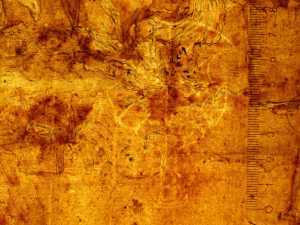Specifications
| Title | Theagenes and Chariclea Amidst Slain Pirates on the Bank of the Nile Estuary (‘After the Shipwreck’) |
|---|---|
| Material and technique | Black chalk, pen and brush and brown ink, brown wash, heightened with white, framing lines with the pen in black ink (cut off in places) |
| Object type |
Drawing
> Two-dimensional object
> Art object
|
| Location | This object is in storage |
| Dimensions |
Height 250 mm Width 293 mm |
|---|---|
| Artists |
Draughtsman:
Abraham Bloemaert
|
| Accession number | MB 1980/T 2 (PK) |
| Credits | Purchased 1980 |
| Department | Drawings & Prints |
| Acquisition date | 1980 |
| Creation date | in circa 1624-1625 |
| Signature | none |
| Watermark | coat of arms, unidentified (quartered: bend in 2 and 3, rampant lion in 1 and 4, but difficult to distinguish), initials BL in ligature beneath (75x58mm, on P4-5 from the left, right under the heads of the main characters; vH, 12P, fine, bifolio), the same type of watermark is present in a drawing by Jacob Matham in Museum Boijmans Van Beuningen, inv. JMat 2, and fragmented in one by Cornelis Claesz. Van Wieringen, inv. CCW 1): coat of arms (mirror image) of an unidentified family (Baden-Hochberg according to Briquet vol. 1, p. 89, but this family has another coat of arms)(quarterly: bend in 1 and 4, rampant lion in 2, half of an emerging lion on waves in 3), initials BL in ligature beneath, similar to Briquet 1075 (probably papermaker BL in Ettlingen, below Karlsruhe, county of Baden, Germany; doc. 1589-1601 but used well into the 17th c., a.o. doc. Utrecht 1589-1602, Leiden 1597; Briquet vol. I, p. 89)) and Heawood 602-604 (with other initials; doc. resp. Holland 1604, 1611, 1627) and 605 (without the bend but with the same initials BL in ligature; doc. Holland 1611). [AE] [for images click thumbnails above the 'zoom in' option] |
| Condition | two vertical folds near the centre, y foxing, discoloration due to former passe-partout |
| Inscriptions | none |
| Mark | none |
| Provenance | Valerius Röver (1686-1739), Delft (inventory 1736, nos. V 81 and X 14, 32); sale (Pieter de Haan ‘en nog een voornaam liefhebber’)[Amsterdam UB, inv. nr. II A 18]; Amsterdam (De Winter/Yver), 9 March 1767, Album B, no. 84 (‘De Schipbreuk van Ulisses, op de voorgrond ziet men eenige dooden leggen, en op de tweede grond werd Ulisses opgenomen door Circe’, fl. 4,5 to Yver); sale, Amsterdam (De Winter/Yver), 23 November 1767 sqq., Album G, no. 530 (‘Een Schipbreuk, waar in men op de Voorgrond verscheyde doode Lyken ziet leggen.’); art dealer H.J. Stokking, Amsterdam; acquired by the museum, 1980 |
| Exhibitions | Utrecht/Schwerin 2011, no. 50 |
| External exhibitions |
Abraham Bloemaert. Een grootheid uit de Gouden Eeuw (2011) Abraham Bloemaert - Een grootheid uit de Gouden Eeuw (2012) |
| Research |
Show research Netherlandish Drawings of the Fifteenth and Sixteenth Centuries |
| Literature | The Hague 1997-1998, pp. 104-105, ill. 2; Plomp 2001, p. 202, no. 20; Bolten 2007, no. 554; Elen 2011, pp. 32-37, ill. 16 |
| Material | |
| Object | |
| Technique |
Highlight
> Painting technique
> Technique
> Material and technique
Brown wash
> Washing
> Wash
> Drawing technique
> Technique
> Material and technique
|
| Geographical origin | The Netherlands > Western Europe > Europe |










 fig. 1 Abraham Bloemaert. Theagenes and Chariclea Amidst Slain Mariners (after the Shipwreck), 1625. Berlin-Brandenburg, Stiftung Staatliche Schlösser und Gärten (Potsdam, Schloss Sanssouci)[/caption]
fig. 1 Abraham Bloemaert. Theagenes and Chariclea Amidst Slain Mariners (after the Shipwreck), 1625. Berlin-Brandenburg, Stiftung Staatliche Schlösser und Gärten (Potsdam, Schloss Sanssouci)[/caption]















